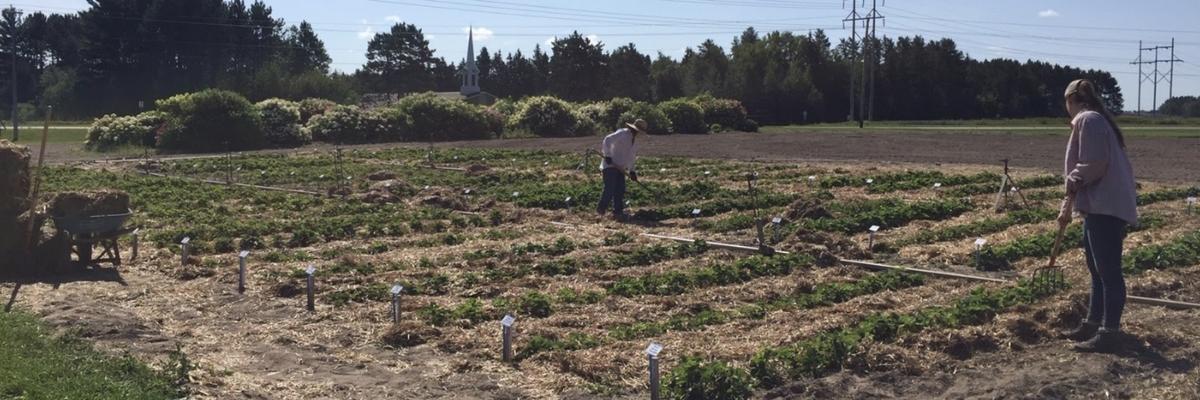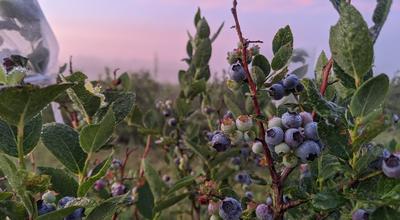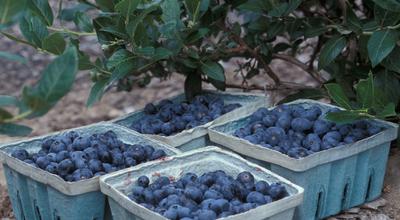About the trials
Results of Junebearing strawberry trials planted at two locations in 2020 and harvested in 2021 are summarized here. Additional results are included from the 2018 harvest at Morris from planting established in 2018 and harvested in 2019. Unfortunately, the planting could not be harvested in 2020 due to COVID restrictions.
Rows were 4 ft apart on center and plants were allowed to form a matted row up to about 18 inches wide. The plantings were mulched with about 4-6 inches of straw in early November and uncovered in late April (Morris) or early May (Grand Rapids). Plots were harvested every 2 or 3 days. The total weight of fruit from each plot was weighed to estimate yield and the weight of 20 berries was used to estimate berry size at each harvest date. Insecticide sprays were applied for tarnished plant bug or cyclamen mites as needed.
Performance in 2021
At Grand Rapids, fruit yields were very minimal in 2021 due to stand loss due to a combination of winter injury and root rot and two freeze events during the May bloom period and are not reported here. Plots were consolidated in summer 2021 and by fall 2021 stand coverage was mostly 70-90%.
At Morris, stand loss over winter was minimal. However, fruit size was relatively small in 2021 due to extreme heat in June. Data for five additional varieties (Genereuse, Glooscap, Red Merlin, St-Jean d’Orleans, St-Pierre) that were planted several weeks later in 2020 are not reported here. It should be noted that plants of Glooscap appeared to be free of the June Yellows symptoms that had been noted on this variety in previous years.
Among the newer varieties, Sonata was notable for its high yield at Morris in 2021. Keepsake and the new AAC varieties from Nova Scotia had excellent firmness and flavor.
Click here to view a slide set presented at the 2022 MN Fruit and Vegetable Expo.
Click here to view the trial summary tables.
Recent introductions - Observations from 2015 through 2021
AAC Audrey (Nova Scotia) – Early midseason, medium yield, med fruit, Excellent firmness, uneven ripening with white tips, excellent flavor, some winter injury
AAC Evelyn (Nova Scotia) – Late midseason, medium yield, medium fruit size, good firmness, weak skin, irregular shape on primaries, excellent flavor, some winter injury
AAC Lila (Nova Scotia) – Early midseason, productive, med to large fruit, Excellent firmness, darkish color and long neck with some cracking, excellent flavor, some winter injury
Archer (Cornell, NY) – Late midseason, firmer than Jewel, very good appearance, blotchy color, irregular shape, strong flavor and acid
Dickens (Cornell, NY) – Jewel season; Hardiness, yield and berry size similar to Jewel, firm, good flavor
Flavorfest (USDA-Maryland) – late season, poor hardiness, medium yield, medium to large size, beautiful fruit, excellent flavor and firmness, susceptible to Angular Leaf Spot
Galletta (NC State Univ) – early-midseason, medium yield, med to large size, outstanding flavor and firmness, dark color, questionable hardiness
Herriot (Cornell, NY) – poor yield and hardiness
Keepsake (USDA, MD) –Late season, medium yield, medium fruit size, very attractive fruit with excellent firmness and outstanding flavor
Malwina (Germany) – very, very late, low yield, large fruit, soft, fair to good flavor
Mayflower (England) – very late, medium yield and size, beautiful very firm fruit, fair flavor, good firmness, questionable hardiness
Record (Italy) – very late, high yield, large firm fruit, light color, lumpy, falls apart in wet weather
Rubicon (Connecticut) - medium yield and size, beautiful fruit, excellent flavor and adequate firmness
Rutgers Scarlet (NJ) – late season, Hardiness?, very good flavor, very susc to leaf diseases
Sonata (Netherlands) – Jewel season, very good yield and size, lumpy, bad cracking in wet weather
Yambu (Netherlands) – early midseason(Cavendish), good yield and size, attractive, very firm but bland flavor, weak plant, cracking in wet weather
Acknowledgements
We gratefully acknowledge AgResource Inc. for providing plants and The Minnesota Fruit and Vegetable Growers Association for partial financial support.
Research team
Jim Luby - Univ. of Minnesota, Department of Horticultural Science, St. Paul, MN
Steve Poppe, Nathan Dalman - Univ. of Minnesota West Central Research and Outreach Center, Morris, MN
Crystal Sucher, Rosmanita Learmont, Keith Mann - Univ. of Minnesota North Central Research and Outreach Center, Grand Rapids, MN



